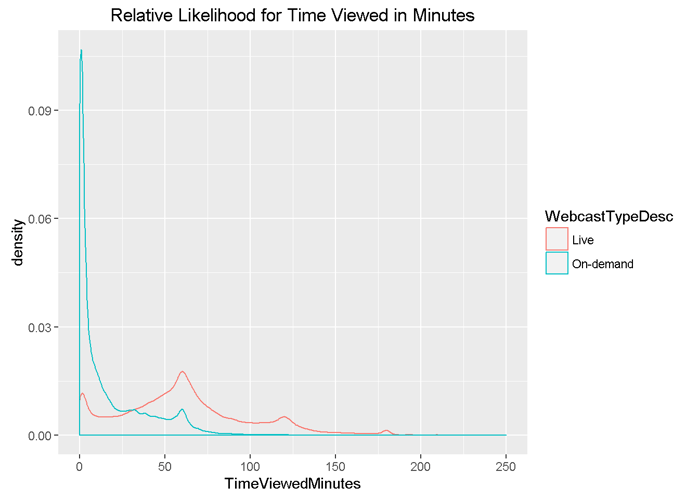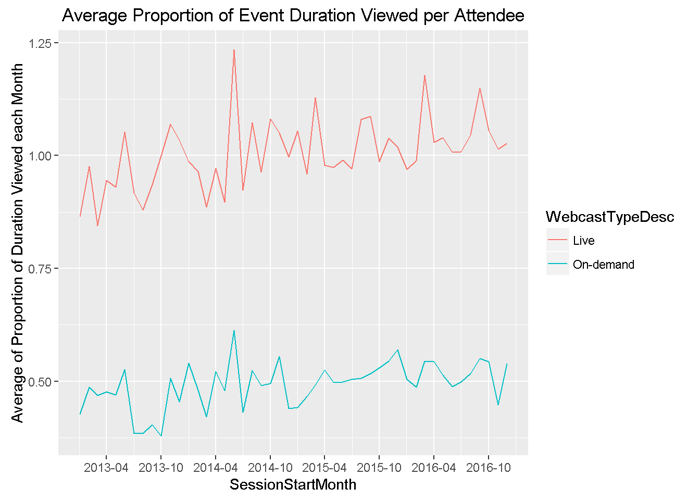[Updated Nov 2024]
When it comes to webinar best practices, there's a vast array of advice available. Yet, what often makes the difference is having solid data to substantiate these insights.
This is where WorkCast steps in. We conducted an extensive analysis of over four years' worth of webinar data (that’s 1,460 days), closely examining webinars hosted on the WorkCast platform.
From this deep dive, we compiled 1.2 million rows of event session data, translating them into charts, graphs, and plots to extract meaningful insights. With this extensive dataset, we identified key best practices and debunked several long-standing webinar myths, such as the belief that live webinars inherently outperform on-demand ones in attracting and engaging attendees. But is that really the case?
The Drop-Off Point
An effective way to measure how engaged audiences are throughout a webinar is to measure when viewers start to drop off (literally sometimes).
Viewing statistics look impressive when you list how many people attended a webinar. However, what’s more impressive, is how long they attended the event for.
The below density graph shows the relative likelihood for time that attendees viewed an online event - comparing both live and on-demand attendees.

This graph demonstrates that viewers of on-demand webinars were much more likely to watch less than ten minutes of a webinar, when compared to live attendees. This could be attributed to the fact that there are simply more who choose to watch events at their leisure, via on-demand.
Live attendees were also found to be more likely to watch half an hour or more, when compared to on-demand viewers.
Why? Well, those in attendance have made a commitment to attend at a certain time, so they are more likely to follow through with viewing the entire event, unlike on-demand viewers, who can view at any time.
As they’re attending for longer, the likelihood they’ll be more engaged with the webinar is greatly increased.
Proportion of Events People View
So, we’ve established that on-demand webinars do have limitations when it comes to keeping viewers engaged. But, of the monthly attendees over that four-year period, what was the average proportion of an event that they were actually viewing?
Not to get too technical, but the formula to work out the proportion of an event viewed is:
Time Viewed
————————
Webinar Duration
At this point, we’ll note that the webinar duration figure is accurate for on-demand events, however the live event figure isn’t updated after the event to reflect the actual running time.
So here, we’ll concentrate on the on-demand event plot.

As you can see, on average, on-demand viewers were watching around 0.5 (half) of the events they chose to initially watch (which is a disappointing figure).
If they’re only viewing half of your content, then they’re clearly less engaged with the content they’re consuming. But, the point could again be made, is it only natural to do this when the viewers are not forced to watch the event at a certain time?
As they can pop in and out of a webinar at any time, they perhaps aren’t concentrating for long enough to be engaged with what’s being presented.
Conclusion
While on-demand webinars offer valuable flexibility and accessibility, they do come with limitations when it comes to creating direct connections and engaging meaningfully with viewers.
In contrast, live webinars captivate a registered audience who have specifically chosen to participate on the scheduled day, resulting in higher engagement levels. Instead of passively listening to a pre-recorded session, live events allow attendees to actively interact, participate in real time, and feel part of the experience. This interactivity often keeps attendees engaged longer, allowing them to absorb more of your message.
On-demand sessions, on the other hand, serve an important role by extending the lifespan of your content. They act as a valuable informational resource and a compelling reference point, giving potential attendees a taste of what to expect from future events.
The takeaway? Live webinars excel in fostering real-time engagement and audience interaction, while on-demand content serves as an effective reference tool to drive interest in future events.
Other Blogs You may be Interested in!
7 Surprising Things to Consider When Choosing Webinar Software
Where am I going Wrong with My Webinars? Troubleshooting Common Problems
Share this
You May Also Like
These Related Stories

What is a Webinar?

Boost Webinar ROI with CRM and Marketing Automation Integration



